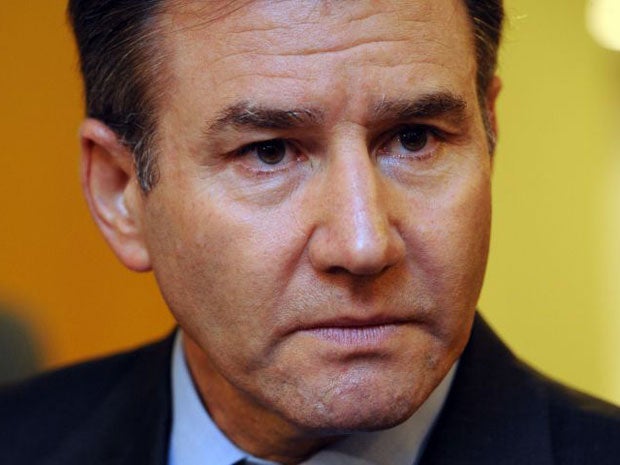The man who bought the world – and then saw its price plummet
The downturn in China and fall in commodity prices have left Ivan Glasenberg's once mighty Glencore nursing debts of $30bn


As teenage boys, we used to play the board game Risk. It’s about world domination (in France it’s called “La Conquête du Monde”), and the winner is usually the one who takes over the most valuable countries.
Risk is still on sale: I saw a set just the other day. For a moment I was taken back to sweaty living rooms and fierce arguments about moving the pieces around.
I’ve no idea if the young Ivan Glasenberg was a Risk devotee. I like to think he was, that he first learned the techniques that have seen him build his company, Glencore, into a mining and commodity giant while hunched up over a piece of cardboard.
Certainly, in the way he has stalked the globe, amassing an empire in metals, cereals, coal and oil, Glasenberg exhibits all the hallmarks of a testosterone-fuelled Risk aficionado. A tough-talking South African accountant, Glasenberg is someone who does not appear to know the meaning of the word “enough”.
Glencore was originally Marc Rich & Co, the Swiss commodity firm run by the late Marc Rich. (He was a fugitive from the US, where he was wanted for tax evasion and sanctions-busting, but was later pardoned by President Bill Clinton). From there Glencore grew to become one of the largest companies in the world.
Glasenberg took it to new heights, merging with the mining colossus Xstrata and, in 2011, listing on the stock market in London’s biggest-ever flotation. And he didn’t stop there: despite still absorbing the £42bn purchase price for Xstrata, he proposed merging with another miner, Rio Tinto, only for his approach to be rejected.
Along the way he made himself spectacularly wealthy. His share stake was worth more than £6bn. And it wasn’t just him: five other top executives of Glencore became billionaires when it floated, and dozens more were made into multi-millionaires. The banks involved shared a whopping $258m (£168m) in fees.
No matter that in other circles the company aroused controversy, with charities lining up to accuse it of acquiring too much of the planet’s precious natural resources, exploiting local, cheap labour and trading with some of the world’s most disreputable regimes.
Now, though, the behemoth has been felled. The downturn in China and the fall in commodity prices have left Glencore nursing debts of $30bn. One of the metals worst affected is copper. It’s reckoned that every 10 per cent reduction in the price of the metal accounts for $1bn of Glencore’s profits.
Glasenberg, who does not like being told what to do by anyone, has had to bow to shareholder pressure and agree to reduce the size of the company’s borrowings. The shares are the worst performers on the FTSE100 index this year, and have more than halved since May – his own stake is down more than £4bn. Meanwhile, to rub salt into Glasenberg’s gaping wound, hedge funds have made fortunes betting the shares would fall further. In one scenario, drawn up by one of the banks, they crash completely, becoming worthless as commodity prices tumble.
Glencore’s crisis is of its own making. Glasenberg and his colleagues built a company that was so big and diverse as to be impervious to falling commodity prices – or so they believed. They did not just mine metals, they traded them as well. They operated across life’s necessities – commodities that would always be in demand, providing insurance against falls elsewhere. They thought they could defy the economic cycle, putting their faith in the “super-cycle” and maintaining that prices would go on climbing forever.
Unfortunately, as they drove Glencore towards becoming bigger than many nation states, they reckoned without the second biggest economy on Earth taking a turn for the worse.
Glencore’s inability to see that world prices were set at the very least for a correction, if not a drop, plus its dependency on China to keep motoring is a puzzle. Glasenberg earned his reputation within the organisation as a star coal trader. He made his move on Xstrata just when the markets started to turn. They’ve been heading in that same direction ever since, helped by a downturn in demand in China.
Normally, Glasenberg’s calculations are accurate. Years ago, I went to Zug in Switzerland, hoping to interview Rich. I was looking into an aluminium scam in London and Rich’s involvement was suspected.
Rich would not see me. But one of his henchmen did. He asked why I was so interested in aluminium – it was so passé. When I asked what should I be focusing on, he replied: “Copper. Six months from now, make a note of where the copper price is.” Six months to the day, the news headline was “Copper reaches all-time high – suspected buying by Marc Rich”.
By buying up a large proportion of the world’s stock of a commodity, Glencore is able to influence the price, determining how much should be available to buy and ensuring demand stays tight, and profits high. The fact that the commodity might be a much-needed metal or a staple food and people could be unemployed or starving is not the company’s concern.
Glencore’s stranglehold was illustrated perfectly by the moves it took to curb its debt mountain. One was the suspension of mining for 18 moths at Mopani in Zambia, and Katanga in the Democratic Republic of Congo. These are enormous plants – Glencore employs 8,000 at Mopani and 5,000 at Katanga. It’s uncertain what will happen to these jobs in the interim.
Glencore continues to mine copper elsewhere. Because the halt meant 400,000 tonnes of copper would not be coming on to the market, the price of the metal rose, and with it Glencore’s much-battered shares. They rose 7 per cent when details of the restructuring – which also included not paying investors a dividend – were announced.
Glasenberg, like so many before him, succumbed to his own publicity. But he forgot the most basic rule of all: that prices can go down as well as up. Even the best players at Risk, have to suffer the throw of the dice. In short, as a commodities man he reaped what he sowed.
Join our commenting forum
Join thought-provoking conversations, follow other Independent readers and see their replies
Comments